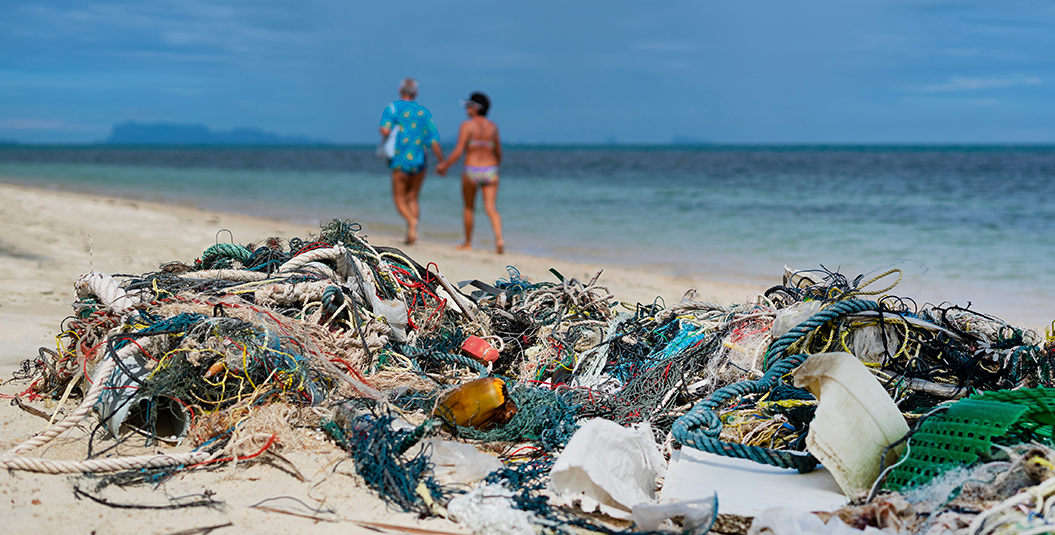Reeling in the gear: New standards to reduce plastic waste from fishing
ECOS has been an active participant in the development of new European standards for the ‘Circular design of fishing gear and aquaculture equipment’. These standards will help to reduce plastics, microplastics, and other waste in our oceans that harm wildlife.

Over 10% of plastic in our oceans, or ‘marine plastic’, comes from fishing gear and other related items. This amounts to hundreds of thousands of tonnes of plastic every year. Fishing and aquaculture equipment are the second most common plastic items found in the sea. This waste harms fish, mammals, and birds through entanglement, fatal ingestion, habitat damage, and species loss. Due to the toxic nature of plastic and its resilience to degradation, plastics also heavily impact marine fauna and flora over long periods. Marine plastic also affects the productivity, safety, and profitability of fishing itself – the sector is considered particularly vulnerable to the impacts of plastic.
Developing a standard for the circular design of fishing gear
ECOS has been an active participant in the development of new European standards for the ‘Circular design of fishing gear and aquaculture equipment’ (EN 17988 series). Now in the last stage of the standardisation process, this series of standards originated from the EU Single Use Plastic Directive (‘SUPD’ 2019/904) and aims to address wide-ranging issues of fishing-related plastic waste.
We ensured that circular economy principles and best practices were included throughout all six parts of the standards. We offered specialist expertise and guidance and, cross-referencing with other published standards, we submitted amendments and suggestions on each of the committee draft documents, e.g. to avoid detrimental substitution from “biodegradable” products. Overall, EN 17988 is a strong series of standards. Some compromises were made on wording, such as “consider designing out” instead of “eliminating” substances of concern, which can leave the door open for weaker action, but ultimately these standards will support the circular design of fishing gear and can contribute to a meaningful reduction of marine plastics when combined with a well-functioning EPR scheme for fishing gear.
These new European standards can help to not only implement national regulations but also help achieve the goals of international agreements such as the UN Global Plastics Treaty. At the national level, EN 17988 can support the development of extended producer responsibility schemes for fishing gear, making a clear case for stewardship and accountability considering all lifecycle phases.
Internationally, the Plastics Treaty will be a ‘legally binding instrument on plastic pollution, including in the marine environment’ and is due to be finalised in December 2024 in South Korea. The EN 17988 standard series is therefore perfectly poised to offer measurable, actionable, and impactful change to the complex issues of plastic waste related to fishing and aquaculture.
What is the EN 17988 standards series?
The EN 17988 series comprises six separate standards, which increase the circularity of gear in all forms. Along with CEN/TS 18101, which sets the relevant terms and definitions, they cover comprehensive aspects such as:
- Technical requirements.
- Environmental and circularity requirements.
- Digitisation and information.
- Circular business models.
These standards cover the entire life cycle of fishing products – from the earliest design stages all the way through to possible end-of-life gear and many stages in between. EN 17988 standards will offer a full overview – from materials to manufacturing – whilst also outlining opportunities for new pathways that will reduce the impact of fishing gear when it can no longer be used.
We have ensured that circular economy principles underpin these standards – considering the waste hierarchy for decisions at different stages – repairability, modularity, reduction in materials, increased use of recycled materials, and much more feature in each of the six standards. The environmental impact of fishing and aquaculture gear is so wide-ranging, the EN 17988 series therefore provides a good opportunity to create meaningful and impactful change.
The EN 17988 series will be finally adopted in November 2024 and publication is set for 2025. It will provide detailed and specific guidance for the fishing industry to transition away from a linear to a circular economy.
You can register here for the European stakeholder meeting on 28 November 2024 in Brussels, where CEN/TC 466 “Circularity and recyclability of fishing gear and aquaculture equipment” will present these new European standards, at the European Commission’s premises.

 By
By  By
By 
